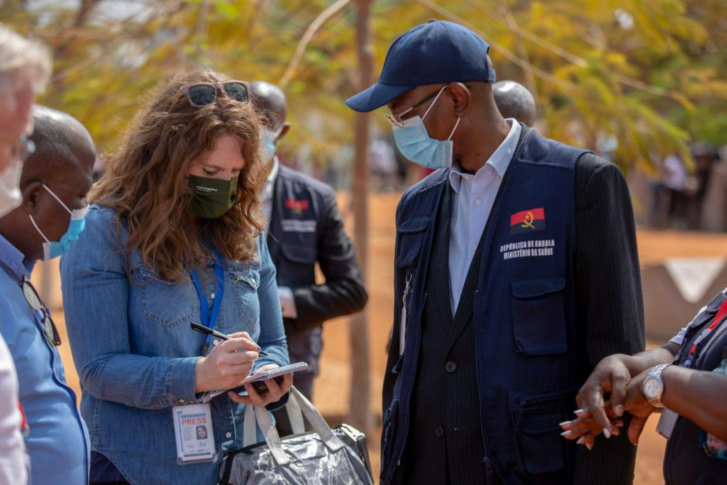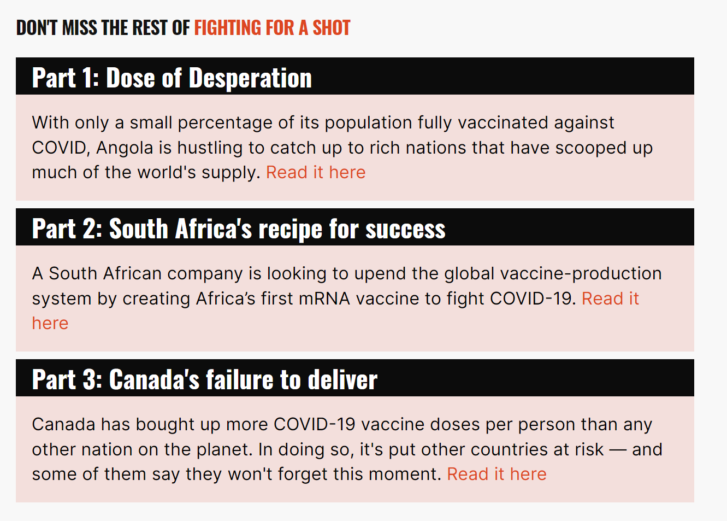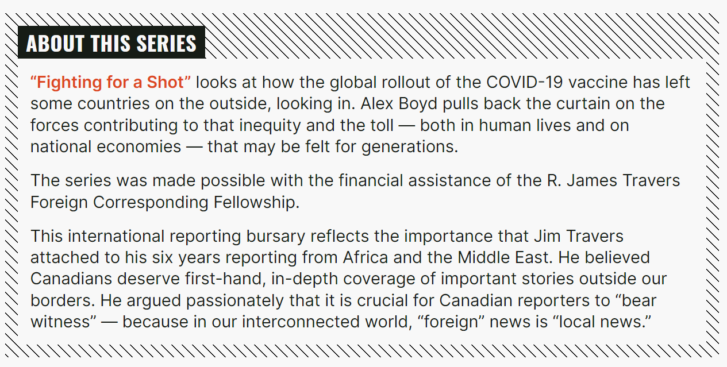Three-part series delves into what went wrong with the global vaccine rollout — and what the consequences will be
As I stepped into the shade, a blue-gowned staffer waved me into a room nearby.
“Your vaccines, they’re in here,” he said, prying up the top of the chest freezer to reveal boxes upon boxes of tightly packed vials.
They weren’t mine, exactly. They’d been paid for by Canada and shipped here, to Angola. I was just a Canadian reporter who’d grabbed a last-minute chance to see one of my country’s donations arrive in a country where, at the time, only five per cent of the country was fully vaccinated. Now, we were at an impromptu vaccine clinic in the courtyard of a teachers’ college.
Somewhere over the course of my travels, I noticed some people had started referring to these vaccines as mine — “your vaccines have just arrived,” or “we’ll start using yours next,” they’d say, seemingly keen on demonstrating, even to me, how quickly and effectively the doses were moving.
It was an uncomfortable reminder that the global vaccine rollout has become a charitable endeavour.

Countries such as Angola know that their supply of vaccine depends on proving to a bunch of faceless international entities that they can handle the big-kid responsibilities of distribution. And they are keen to do just that.
I was in Angola as part of a reporting trip funded by the R. James Travers Foreign Corresponding Fellowship. I hoped to explain to a Canadian audience why the global vaccine rollout had become so glaringly lopsided. The product of that trip, and months of work, are being published this week by the Toronto Star in a three-part series, “Fighting for a Shot.”
I was, retrospectively, the walking embodiment of my story — a privileged Westerner who had been vaccinated months earlier and had parachuted into a new country to ask people, face to face, what it felt like to not have had the same good fortune.
Canadians often say they feel a genuine sense of obligation to the world. Many of us like that Canada is a country that helps others. But the reality of the vaccine rollout cannot help but challenge your perceptions.

Take Angola. This is a country where generations were sold into slavery to generate a profit for a colonial power. Then, it was pumped full of weapons by adversaries during the Cold War. Even now, westerners are flown in and out for high-paid work on offshore rigs, while the average Angolan survives on less per day than the price of a coffee.
The Angolan government has grappled mightily to push forward while healing the wounds of the past, and this new virus has thrown a pretty large wrench into the system. Struggling to compete on the international vaccine market, the country was left to fling itself on the generosity of an international community that has promised much and delivered little.
Canada has pledged to share with the world. Sitting on the largest stockpile of doses in the world, relative to population, it’s undoubtedly the right thing to do. But in the same way that someone donating to a homeless shelter might take a moment to reflect on the deeper roots of poverty, Canadians could also mull why countries like Angola are so dependent on handouts at all. Why do the countries with the lowest rates tend to be those decimated by colonialization?
How we see vaccines in this country has been shaped by our own bounty.
In Canada, exhausted, terrified parents are pushing to get access to vaccines’ protection for the smallest members of their families. I empathize with the struggle to protect the most vulnerable among us. But it’s hard to square that with public health experts in developing countries who are agog at us for giving precious shots to children who, while vulnerable to COVID, remain at lower risk for serious outcomes.
Let us be frank. If we really were a global community, there would be no way a toddler in Toronto would be vaccinated before a grandmother in Africa.
I was struck by the relative youthfulness of the people I met as they endured hours-long lines for a limited supply of AstraZeneca in Angola. Many were in their 20s and 30s, in sharp contrast to Canada, where a steady flow of several top-shelf vaccines enabled public officials to recommend different doses for different age groups.
As your nearest Gen Xer can probably tell you, the result was that AstraZeneca ended up being primarily used for people in their 40s, hordes of whom turned up to take it as a first dose. The media cheerfully dubbed them “Generation AZ.”
This distinction does not exist in Angola. It was jarring to see people my age and younger rolling up their sleeves for AstraZeneca, after months of tut-tutting from Canadian health officials.
When I awkwardly broached the question of risk with some of the younger Angolans — a line of questioning that felt greasy, as someone who hailed from a place where extra vaccines were now getting tossed out — they said they were enthusiastic to be getting any shot at all. Still, it felt like a glaring illustration of the fact that erring on the side of caution is just another privilege of the rich.
As I was casually chatting with a few local health officials afterward in an interview, in which they told me in great detail just how much work they’d put into creating the best vaccine distribution system they could, one of them made what was mostly a joke.
“When you get home, tell Justin Trudeau to send more!”

Article From: The Star
Author: Alex Boyd

